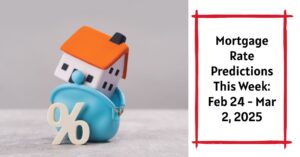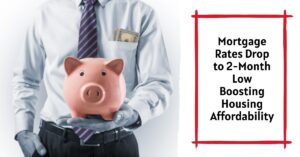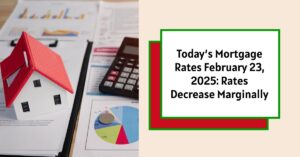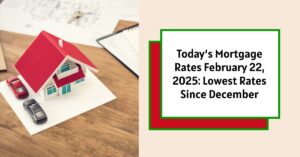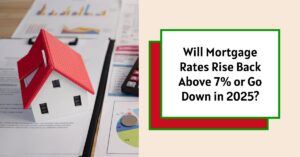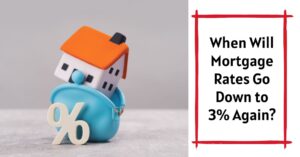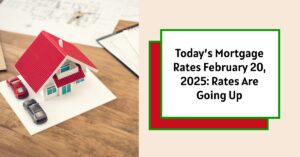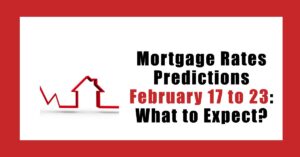Worried about where mortgage rates are headed this week? You're not alone! Based on current trends and expert analysis, mortgage rate predictions this week, February 24th to March 2nd, 2025, indicate rates will likely hold steady, hovering between 6.5% and 7%. While this isn't the rock-bottom rates we saw a few years ago, it's crucial to understand why rates are where they are and what you can do as a potential homebuyer or homeowner. Let's dive in.
Mortgage Rate Predictions This Week: February 24 – March 2, 2025
The mortgage world has been quite complex for buyers. It's influenced by everything from inflation to the Federal Reserve's policies. Right now, we're seeing a slight easing in mortgage rates, which is good news. However, affordability is still a major concern for many.
To get a good handle on where things stand, let's look at some recent data. According to Freddie Mac’s Primary Mortgage Market Survey from February 20, 2025, here’s the snapshot:
- 30-Year Fixed Rate Mortgage (FRM): 6.85%
- 1-Week Change: -0.02%
- 1-Year Change: -0.05%
- 4-Week Average: 6.89%
- 52-Week Average: 6.76%
- 52-Week Range: 6.08% – 7.22%
- 15-Year Fixed Rate Mortgage (FRM): 6.04%
- 1-Week Change: -0.05%
- 1-Year Change: -0.25%
- 4-Week Average: 6.08%
- 52-Week Average: 5.99%
- 52-Week Range: 5.15% – 6.47%
These numbers tell a story: rates have come down slightly recently, but they're still significantly higher than what many consider affordable.
What's Driving Mortgage Rate Trends?
Several factors are playing a big role in shaping where mortgage rates are going:
- Inflationary Pressures: Remember when prices were skyrocketing for everything? Well, inflation is still higher than the Federal Reserve would like. The Fed is targeting 2% inflation, but we're currently around 3%. This makes it less likely that the Fed will cut interest rates anytime soon.
- Federal Reserve Policy Outlook: The Fed uses interest rates to control inflation and keep the economy humming. Because inflation remains a concern, most experts believe the Fed will keep interest rates where they are for a while. They're waiting for more convincing signs that inflation is truly under control. Any potential rate cuts largely hinges on the economic cooling, which isn't expected in the immediate future.
- Increasing Housing Inventory: Here's some good news! More homeowners are deciding to sell, which means there are more houses on the market. This increased inventory could help to stabilize, or even lower, housing prices. More options for buyers is generally a positive sign.
- Bond Market Behavior: Mortgage rates are closely tied to the 10-year Treasury note. This is essentially a bond issued by the government. If the economy looks strong, and inflation is still high, bond yields (and mortgage rates) tend to rise. If inflation shows signs of cooling down, rates might decrease.
In my experience, patience is key in times like these. We are in a period where the market is adjusting. It is certainly not the time to panic. Home buying and selling decisions must be well thought out and not in reaction to media headlines. I am advising my clients to focus on the long-term value, negotiate wisely, and be prepared to hold their properties through these fluctuating times.
Looking Ahead: Predictions for the Week of February 24 – March 2, 2025
Based on everything I'm seeing, I predict that mortgage rates will likely remain within the 6.5% to 7% range this week. It’s hard to see any major movement in either direction.
While this may be higher than some people would like, it's worth remembering that these rates are closer to the historical average for 30-year fixed mortgages. The super-low rates we saw during the pandemic were an anomaly, not the norm.
Important Considerations:
It's really important to recognize that predictions are just that – predictions. Market conditions can change quickly. Factors like unexpected economic news or shifts in investor sentiment can all influence mortgage rates.
Strategic Tips for Homebuyers
If you're thinking about buying a home, or already in the process, here's my advice:
- Do a thorough financial assessment. Before you even start looking at houses, figure out exactly how much you can afford. Consider not just the mortgage payment, but also property taxes, insurance, and potential maintenance costs. Make sure this budget aligns with your financial goals.
- Work on your credit score. A higher credit score can mean a lower interest rate on your mortgage. Check your credit report for any errors and take steps to improve your score if needed.
- Save for a larger down payment. Putting more money down upfront can reduce your monthly payments and potentially eliminate the need for private mortgage insurance (PMI). It also shows lenders that you're a serious buyer.
- Shop around for the best rate. Don't just go with the first lender you talk to. Get quotes from multiple lenders to see who can offer you the best deal. This can save you a significant amount of money over the life of the loan.
- Think long-term. Buying a home is a big decision. Consider whether it aligns with your long-term financial goals and lifestyle preferences. Is it the right time for you, or would renting be a better option for now?
Recommended Read:
Mortgage Rates Trends as of February 24, 2025
Mortgage Rates Drop to 2-Month Low Boosting Housing Affordability
Mortgage Rates Forecast March 2025: Will Rates Finally Drop?
Expect High Mortgage Rates Until 2026: Fannie Mae's 2-Year Forecast
Will Mortgage Rates Go Up as Inflation Surges Back Up to 3%
Rent vs. Buy: Is it the Right Time?
This is a question I get asked a lot! The answer really depends on your personal circumstances. Here's a simple table that illustrates some of the key differences:
| Feature | Renting | Buying |
|---|---|---|
| Initial Cost | Lower (security deposit, first month's rent) | Higher (down payment, closing costs) |
| Monthly Costs | Rent, utilities | Mortgage, property taxes, insurance, HOA fees, maintenance |
| Equity | None | Builds over time |
| Flexibility | More | Less |
| Tax Benefits | Few | Potential deductions for mortgage interest and property taxes |
| Customization | Limited | More freedom to personalize |
| Appreciation | None (landlord benefits) | Possible appreciation in property value |
My Perspective
Mortgage rate predictions this week suggest a continuation of the current trends. While it's tempting to wait for rates to drop significantly, remember that this is just one factor to consider.
Having navigated several housing market cycles, I've learned that timing the market perfectly is nearly impossible. Instead, I advise clients to focus on their individual financial situations, long-term goals, and to make informed decisions based on their risk tolerance. It's better to enter the market when you're financially prepared, rather than trying to predict its next move.
By carefully assessing your financial situation, shopping around for the best deal, and focusing on your long-term goals, you can make a smart decision, whether you're buying your first home or refinancing an existing mortgage.
Work with Norada in 2025, Your Trusted Source for
Real Estate Investing
With mortgage rates fluctuating, investing in turnkey real estate
can help you secure consistent returns.
Expand your portfolio confidently, even in a shifting interest rate environment.
Speak with our expert investment counselors (No Obligation):
(800) 611-3060
Recommended Read:
- Mortgage Rates Forecast for the Next 3 Years: 2025 to 2027
- 30-Year Mortgage Rate Forecast for the Next 5 Years
- 15-Year Mortgage Rate Forecast for the Next 5 Years
- Why Are Mortgage Rates Going Up in 2025: Will Rates Drop?
- Why Are Mortgage Rates So High and Predictions for 2025
- NAR Predicts 6% Mortgage Rates in 2025 Will Boost Housing Market
- Mortgage Rates Predictions for 2025: Expert Forecast
- Will Mortgage Rates Ever Be 3% Again: Future Outlook
- Mortgage Rates Predictions for Next 2 Years
- Mortgage Rate Predictions for Next 5 Years
- Mortgage Rate Predictions for 2025: Expert Forecast
- Mortgage Rate Predictions: Why 2% and 3% Rates are Out of Reach
- How Lower Mortgage Rates Can Save You Thousands?
- How to Get a Low Mortgage Interest Rate?
- Will Mortgage Rates Ever Be 4% Again?
